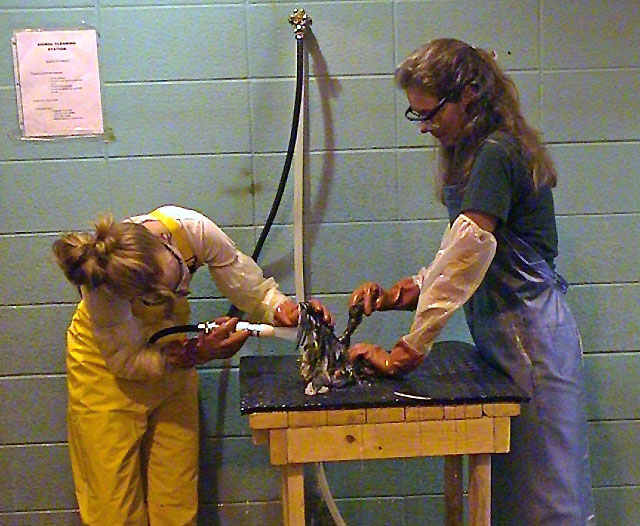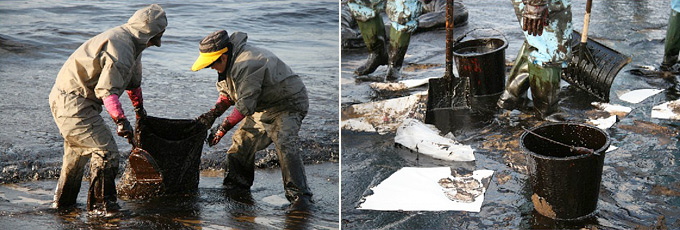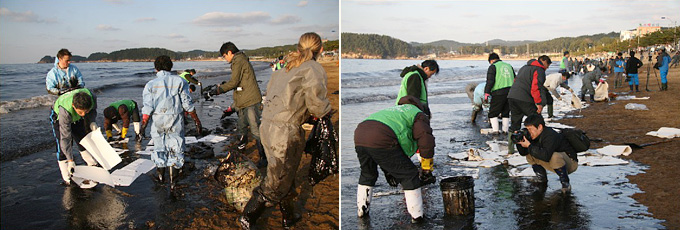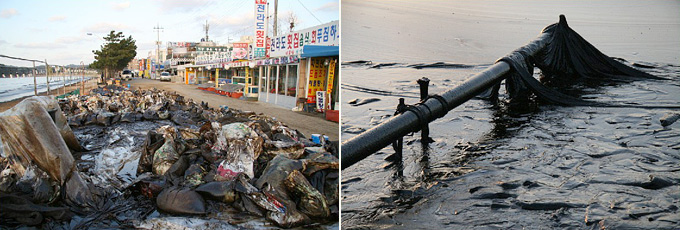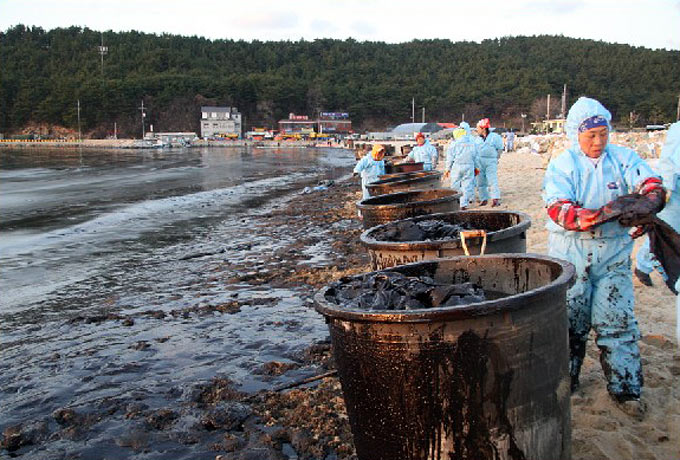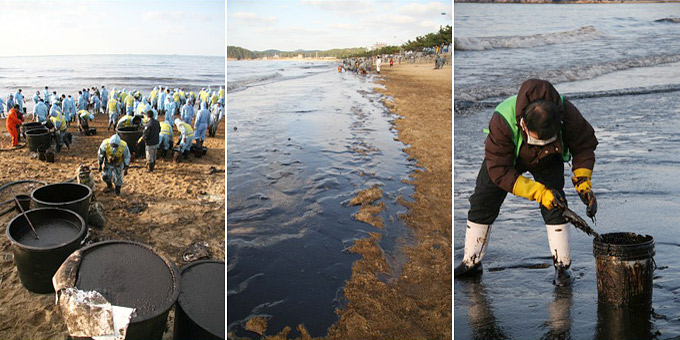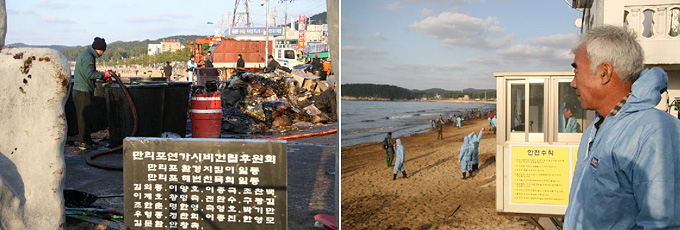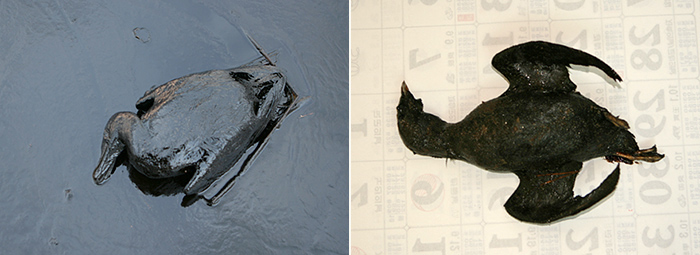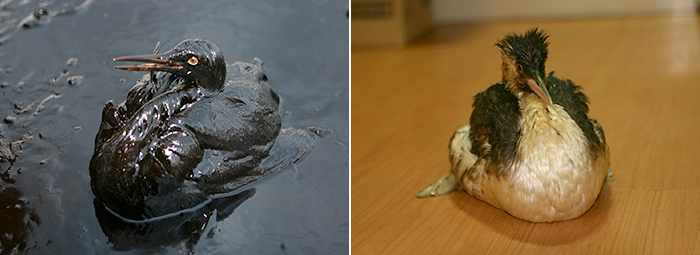|
|
|

|

|
|
The UNDP/GEF Korea Wetland Project has organized a one-day free bus trip for Friday January 25th to bring volunteers from Ilsan/Seoul to Hagampo Beach (Taean-gun National Park) to assist with the local Hebei Spirit oil spill clean-up efforts. Read the details in the Taean-Oil-Spill-Hagampo-Beach-Clean-up.pdf.
For a first-hand account of the oil-spill cleaning efforts, written by Gavin Hudson of Eco-Wordly (December 19th), please go to: The Dark Side of Crude.
Oil Spills and Wildlife Recovery Efforts Birds Korea has been in regular contact with several overseas organisations that specialise in wildlife recovery efforts after major oil spills. The following are a selection of images sent to us by Focus Wildlife International (FWI) in North America (http://www.focuswildlife.net/), showing temporary wildlife rescue centres established in emergency response to oil spills.The temporary centre at Wabamun (in 2005) was paid for by Canadian National Railway, which caused the oil spill. The Canadian National Railway paid for the materials and for all staff time of FWI, and then donated materials to FWI for use in later spills. There are several stages to assist recovery of oiled birds:
Based on 20 years of direct experience, Mr. Chris Battaglia (Executive Director of Focus Wildlife International) states: "The window of opportunity to have a successful wildlife response is very, very limited. The longer it takes to collect the affected birds, the less likely it is that these birds will ever be released. Obviously, poor facilities, resources and expertise will only drive down the release rate even further." These comments and the facilities required need to be considered deeply in light of the recent oil-spill off the Taean peninsula. Those responsible for this massive and damaging spill should be strongly encouraged to provide significant funding to assist in oiled wildlife recovery efforts. These funds should be given to help save oiled birds not only caused by this spill (as now already three weeks have passed, and there is probably little possibility of saving many of the birds that have been oiled), but also to assist in longer-term future wildlife recovery efforts too. Birds Korea December 24th, 2007
Birds Korea Rapid Assessment Survey of Oiled Waterbirds, December 19th-20th, 2007. Preliminary Report. December 20th, 2007. Nial Moores, Ju-Yong-Ki and Andreas Kim (Map). Introduction Following the leak of c. 10, 500 metric tonnes of crude oil from the Hebei Spirit on December 7th 2007, 8 km offshore from the Taean Peninsula (west coast of South Korea), several requests for information have been made to Birds Korea about the likely impacts of this spill on birds. Based on media, eyewitness and official accounts, oil from the spill was initially concentrated on the coastline closest to the spill site – a coastline of relatively low importance to bird populations (i.e. at that season, with no species of special conservation concern, and no species found in internationally important concentrations). Subsequently, a combination of seasonal dry winter-monsoon winds (typically from the northwest), and apparently a seasonal offshore sea current helped the oil to drift south along the coast, creating a potential threat to internationally important concentrations of birds found in the twin Important Bird Areas (BirdLife International, 2004) of Yubu Island and the mainland Geum Estuary (ca 120km to the south from the spill-centre). Some “oil balls” were also reported on shores of the eastern part of the Taean peninsula, in the outer part of Cheonsu Bay, within several kilometers of impounded freshwater reservoirs and rice-fields also supporting very large concentrations of waterbirds. Consideration of the potential threat to the waterbirds of especially the Geum Estuary and Yubu Island increased further when eyewitness reports (both from Mr. Ju Yong-Ki of Birds Korea, and from local fisherfolk) confirmed that on December 15th oil balls started to appear on islands (e.g. Yeon Island, and Kyea Island: the latter only c. 7 km from Yubu Island) and on the mainland, on the northern side of the Dodun Village and peninsula (count site 7: see Table 1), within a few kilometers of the Geum Estuary tidal-flats. Moreover, on December 17th and 18th, several species of bird which had been contaminated with oil were observed on islands and beaches of Taean Peninsula. This included an estimated 34-43 out of 50 in a flock of 600 Dunlin Calidris alpina and Sanderling Calidris alba at count site 14, (for more details, please scroll below) - the first shorebirds reported contaminated by this oil-spill. These were in addition to the 30 or so birds (largely Black-tailed Gull Larus crassirostris, but also Great Crested Grebe Podiceps cristatus, Black-necked Grebe Podiceps nigricollis, Little Grebe Tachybaptus ruficollis, Temminck’s Cormorant Phalacrocorax capillatus and Ancient Murrelets Synthliboramphus antiquus) already taken into care or reported dead by local vet Dr. Kim Shin-Hwan.
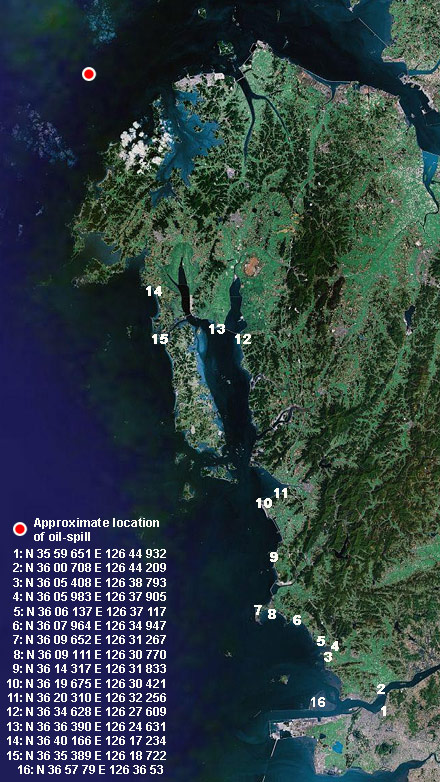 Figure 1: Google map image, with 16 survey count points. The oil spill centre location and extent of spread can be seen in figures below In response, a rapid assessment of oil (presence or absence) and waterbirds (abundance, and number of birds oiled) was conducted at 15 points on December 19th between the Geum Estuary (starting at: N 35 59 651, E 126 44 932) and the southwest of the Taean Peninsula (finishing at: N 36 35 389 E 126 18 722), between 08:30 and 17:30; and on Yubu Island on December 20th (10:00-13:00). Efforts were made to count or estimate the total numbers of waterbirds present at each site (identified to the species level), and active searching of oil on those individuals that could be seen sufficiently well was then conducted. When oil was identified on an individual bird, a score system of 0-5 was then used to describe the approximate extent of oil contamination, with e.g. 1 to indicate light staining or spotting on the underparts, and 5 to indicate almost complete saturation of the plumage. All counts were made through a tripod mounted telescope by Nial Moores (Birds Korea), with further searching for oil on birds and beaches also by Ju Yong-Ki (Birds Korea) and Han Sung Woo (Green Korea United), joined at count points 13-16 by Lee Namue (UNDP-GEF/Ministry of Environment Korea Wetlands Project). Presence or absence of oil at count sites was also assessed through walking along the tide-line at several locations, and in some other locations through interview of local residents encountered on site. All count locations were recorded with a Garmin GPS 60, and digital images were taken of all sites and of some of the oiled birds by Ju Yong-Ki. Some further assessment was also made of wildlife recovery efforts, through visiting two holding centres (outside the Taean National Parks office, and in Seosan City) and through meetings with key personnel, including Dr. Choi Chong Kwan (Chief Manager of the Korea National Park Service), Dr. Jo Ki Man (Korea Animal Rescue and Management Association), and veterinarian Dr. Kim Shin-Hwan (Seosan-Taean KFEM, and member of Birds Korea). Some key elements of these visits and discussions will be included in a follow-up report.
Results No oil was found at any of the count sites on either December 19th or 20th – even though oil had been recorded in the previous days/week at count sites 7, 14 and 15, and vats of oil (which had been collected earlier that same afternoon from inshore sea areas) were watched being unloaded from boats at count site 15. In total, 333 birds contaminated with oil were identified during the two-day survey, comprised of 13 species, with the vast majority (289) made up of a single species, Black-tailed Gull Larus crassirostris. Table 1: Count Locations, and numbers of species and individual waterbirds contaminated with oil (December 19th-20th, 2007).
Table 2: Numbers of Waterbirds contaminated with oil, by species at 16 count sites (December 19th-20th).
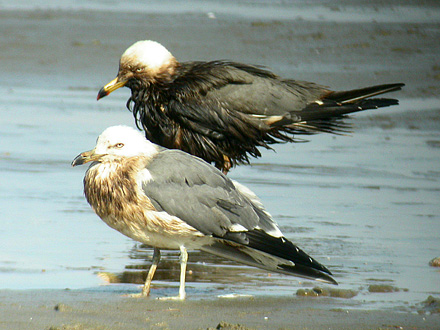 Oiled Black-tailed Gulls Larus crassirostris, at count point 7 on December 19th. During our survey, the gull in the foreground was recorded as 2-3, and the bird to the rear as a 4 on our scale of 1-5 measuring level of oil contamination. Image © Birds Korea.
Conclusions Considering the large area of open sea, the number of islands and the extent of coast and beach affected by oil; the species composition and the likely abundance of birds in the affected given area; and the lack of bird survey coverage, it would seem probable that several thousand birds have so far been contaminated with oil, with the vast majority of these comprised of species that often feed in marine and inshore area (such as Larus crassirostris), with a lesser number of species dependent on tidal-flats and beaches also affected. Many of the birds found contaminated with oil were still relatively active when seen by this survey (many were first located by their very active preening), and would likely be difficult to trap for cleaning – especially without a large, trained team to conduct such activities. Further, we were of the opinion that while the oil clean-up effort has been very well-coordinated and extremely well-supported by volunteers, and while great efforts have been made to clean a few oil-contaminated birds, it is apparent that the existing infrastructure is completely inadequate to deal with the large numbers of birds presently affected.
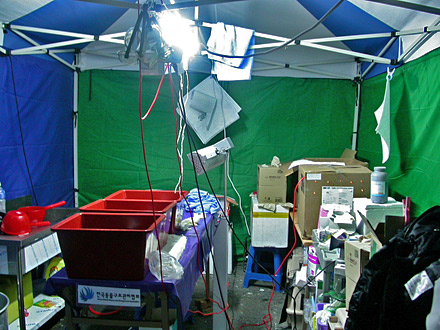 Emergency wildlife recovery centre set up and staffed by the Korea Animal Rescue and Management Association (http://www.karma.or.kr) next to the Taean National Parks office. Image © Birds Korea. Reference BirdLife International (2004). Important Birds Areas in Asia: key sites for conservation. Cambridge, UK: BirdLife International (BirdLife Conservation Series No.13). Note: All information above is open for reproduction by others, provided that Birds Korea is identified as the source.
December 17th-18th Update On December 17th, there was a flock of ca 600 shorebirds (mixed Sanderling Calidris alba and Dunlin C. alpina) at Anmyeon Do, toward the southern end of the Taean peninsula, in an area cleaned of oil by local people. One image taken of this flock by Mr. Ju Yong-Ki shows 75 Dunlin , with probably c. 50 of these in some detail (although distant). Of these Dunlin (assuming that all are in either first winter or adult winter plumage, which is safe assumption by mid-December), it appears that between 34 and 43 show some evidence of contamination by oil, with 2 or 3 birds more heavily marked, and others less so (there is a large margin of error, due to the effects of shadow and range). Mr. Ju Yong-Ki also took one further close-up shot of an oiled Dunlin at the same site.
 Contaminated Dunlin Photo © Ju Yong-Ki On December 18th, on Gai Island, off the Taean Peninsula, Mr. Ju Yong-Gi also saw what was believed to be a live Kentish Plover Charadrius alexandrinus completely covered with oil, and found one dead oiled shorebird. Further field assessment of the impacts of the oil spill on birds, especially shorebirds, will be made by Birds Korea on December 19th and 20th, including at the Geum Estuary, after the degradation of Saemangeum due to reclamation, now South Korea's most important known shorebird site.
West Coast Oil Spill: Birds Korea News Update, December 17th Oil has already coated (and been largely/partly cleaned up from) several kilometers of coast, with much of the thickest oil washed up on c 30 km of beaches (10 km northeast of the spill centre, round to Garolim Bay, and 20 km or more south along the west coast of the Taean peninsula). At sea, the broken slick as of December 17th now apparently extends up to c 130 km south from the spill centre, with oil washing up on beaches and tidal-flats as far south as the Geum Estuary. From previous bird surveys, the Taean peninsula is one of the poorest areas for waterbirds on the Korean coast. However, areas south from there, including most notably the Geum Estuary, are extremely important for large numbers of waterbirds. Birds Korea now believes that the presence of a significantly greater number of experienced specialists in wildlife recovery would be of very great assistance to ongoing domestic recovery efforts at this time. This is because, based on information so far received:
Birds Korea, December 17th, 2007.
Links to additional information an news: The Impact of Oil at Sea on Seabirds in Atlantic Canada Oil Spill off South Korea, Earth Observatory (NASA), December 12 2007 South Korea counts cost of national park oil spill, Reuters, December 10 2007 South Korea spill creates 'oil balls,' threatening fish, The China Post, December 15 2007
A massive oil slick from a tanker collision on Friday, December 7th is now threatening a stretch of coast from the Taean Peninsula possibly as far south as the extremely important tidal-flats and sea areas of the Geum Estuary.
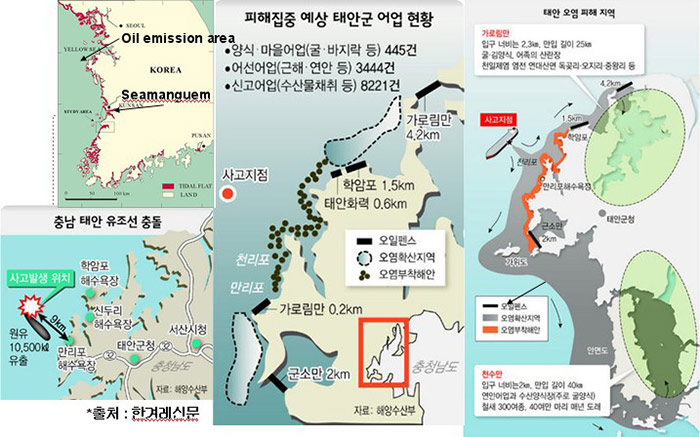
Background details of the accident can be found at:
Looking at the area generally and based on previous survey effort, the area of the Taean Peninsula presently being affected is not an especially important area for birds. However, due to its very great importance for fisheries and for scenic qualities, it is listed as one of the top 22 Priority Sites for Conservation in the Yellow Sea by the ongoing South Korean-Chinese Government/UNDP-GEF Yellow Sea Large Marine Ecosystem Program. Clearly, the spill will cause long-term and extensive ecological damage to the region, in addition to immediate hardship for large numbers of dependent fishing communities.
Further, based on an on-site assessment by Mr. Ju Yong-Gi (Birds Korea Formal Advisor for Saemangeum and the Geum Estuary) who visited the site on December 9th: Both Mr. Ju Yong-Ki and Mr. Nial Moores will likely be visiting the area on 11th or 12th, and we will post further details on our websites as soon as we receive them.
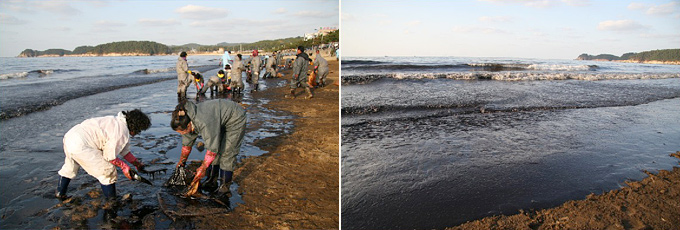
Photos © Mr. Ju Yong-Ki

Photo © Kim Shin-Hwan
*For further information relating to responses to oil spills, please refer to the following URLs, kindly provided by Dr.Nidhi Chauhan Nagabhatla, Post Doctoral Scientist- Landscape Ecology, International Water Management Institute (IWMI):
http://www.epa.gov/oilspill/rescue.htm |

|



